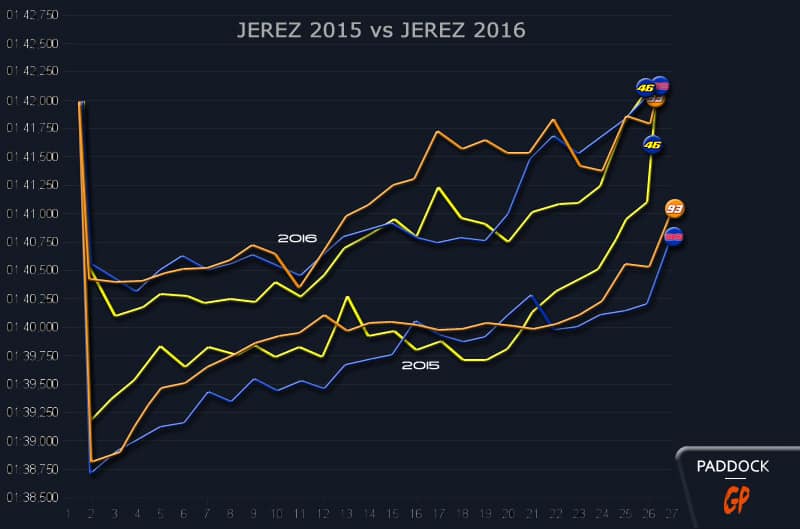Slightly exceptionally, we have today integrated the curves of two Grands Prix into our table, namely Jerez 2016 and Jerez 2015.
The aim is obviously to be able to compare the times of the three best drivers in Bridgestone and Michelin. The diagnosis is clear; the Michelins (+ electronics) are slower than the Bridgestones, by about a good full second.
But what could be more normal for a return to the Grand Prix, especially when you know the safety policy for the men of Clermont-Ferrand?
Without falling into the trap of immediately wanting to compete with the lap times of the "Bridges" (Qatar was a welcome exception), Bibendum therefore chose safety and this is reflected both in slightly slower lap times, but also by a very reduced number of falls (1 in the race in 2016 compared to 4 in 2015, 2 falls over the weekend compared to 17 in 2015!).
The graph also shows us that, Bridgestone or Michelin, the evolution of performances is roughly similar. After the very first laps, the times increase inexorably. Here again, Qatar 2015 is an exception. We still note some small differences which may be important. First of all, Michelins collapse less than Bridgestones ; about a second and a half for Japanese tires compared to a second for French tires.
Then we see that the Bridgestones allowed everyone to set their best time from the second lap, while it takes one or two more for the Michelins. This period of time is currently artificially reduced by the use of the wings which load the front axle, therefore the tire concerned.
By pushing a little further, we realize that Marc Marquez has the widest curves, reflecting the gap between his 2015 Honda and this year's. On the other hand, Valentino Rossi is the one who suffers the least from the arrival of the new tires and the unique software, Jorge Lorenzo falling between these two extremes.
Let's move on to the study of curves 2016 which, in comparison, teach us fewer things.
For the three pilots, everything is fine until the 11th round; the times are stable, even improving for Marc Marquez who accelerates. From there, the tires gradually deteriorate, especially for Marquez who overheated his front tire. From the 16th lap, Jorge Lorenzo hits his tires to get back on Valentino Rossi suffering from straight line skating. It only lasted three laps before his times collapsed, especially as Rossi reacted and managed to widen the gap from the 20th lap until the end of the race.
The funniest fact about it is thatthis is exactly the opposite of what happened in 2015, where Lorenzo suffered a comeback from Rossi from the 16th to the 21st lap.
We wouldn't go so far as to say that this isn't a coincidence, but one thing is clear; In Jerez, this year, between Lorenzo and Rossi, whatever the reasons, the balance of power was reversed in an unusual way.
PS: The lower the curves, the better the times.
PPS: if this type of article interests you, do not hesitate to let us know… Thank you!




